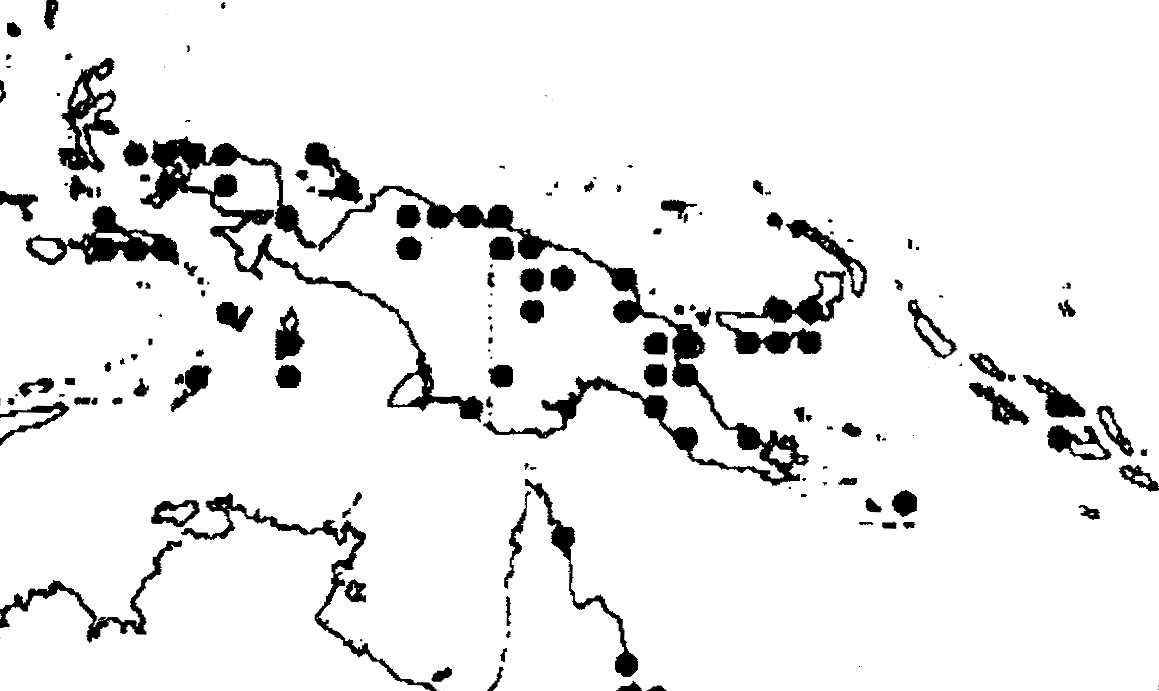
Distribution Map (Barlow 1995)

Description (Barlow 1995)
Dendrophthoe curvata (Blume) Miquel
Loranthus curvatus Blume,
Bijdr. 13 (1825) 665. - Dendrophthoe curvata (Blume) Miquel,
Fl. Ind. Bat. I, I (1856) 820. - Type: Blume s.n.
(not seen), Java, G. Salak.
Loranthus leptopetalus Blume, Fl. Jav. tab. post. ed. (1898)
32. - Dendrophthoe leptopetala (Blume) Danser, Bull. Jard.
Bot. Buitenzorg III, 10 (1929) 309. - Type: not located.
Loranthus lauterbachii Schumann in Schum. & Lauterb.,
Fl. Deutsch. Schutzgeb. Siidsee (1901) 299. - Type: Lauterbach
666 (holo B, not seen; iso WRSL), New Guinea, Huon Gulf, Cape
Ancona, 2. viii. 1890.
Loranthus dolichocladus Schumann in Schum. & Lauterb.,
Fl. Deutsch. Schutzgeb. Siidsee, Nachtr. I (1905) 258.
- Type: Nyman 1068 (holo B, not seen; iso WRSL), New Guinea,
Friedrich Wilhelmshafen, x.1899.
Glabrous except for the young parts, inflorescence, ovary and usually the corolla white- to red-brown-tomentose, the leaves usually soon glabrescent; very rarely completely glabrous. Leaves scattered or subopposite; lamina narrowly to broadly ovate or obovate, (4-)10-15 cm long, (1.5-)3-5(-8) cm wide, attenuate to cuneate at the base to a petiole usually 10-20 mm long, mostly obtuse or rounded (sometimes acute) at the apex, bifacial (often weakly), darker and glossy above or dull on both sides; venation pennate with the midrib and the main laterals visible above and often more distinct below. Inflorescences at the nodes, a (2-)5- to 1O(-16)-flowered raceme; axis 10-25(-30) mm long; pedicels (1-)2-4(-5) mm long; bracts 1-1.5 mm long, acute to rounded. Ovary cylindric to slightly funnel-shaped, 2-3 mm long; calyx limb erect, c. 1 mm long, usually truncate but sometimes irregularly split or finely serrate or rarely 5-toothed. Corolla in mature bud 5-merous, (28-)30-48 mm long, uniformly widened upwards, slightly narrowed to a neck and usually weakly clavate and acute at the apex; tube in the open flower 18-30 mm long and the lobes reflexed 4-6 mm higher, curved, more deeply split on one side. Anther 3-5 mm long, obtuse; free part of the filament 1-2 times as long, rarely with a few scattered stellate hairs. Style slender; stigma capitate, 1.5-2 times as wide as the style. Fruit widest near the base, 8-14 mm long.
Dendrophthoe curvata can be identified among its regional congeners by its combination of scattered, petiolate, bifacial, medium-sized, early glabrescent leaves; racemes inserted singly or few in leaf axils, with relatively few flowers (mostly 5-10) often secund; corolla in mature bud mostly 30-48 mm long, at anthesis with a gradually widened curved tube more deeply split on one side; and stamens lacking a tuft of hairs at the base of the blunt or obtuse anther. Within the genus the species is virtually lacking in unique specialized characters, and thus presents a rather generalized facies. The flower colour is variously described as greenish yellow to orange or (most commonly) red, usually grading from the paler to the darker hues from the base towards the apex; in some areas (especially the Bismarck Archipelago) the direction of this colour gradient is reversed.
The species is distributed widely in Malesia, from Sumatra to New Guinea, the Solomon Islands and North Queensland, but is striking by its apparent absence from the Philippines, the northern Moluccas and the Lesser Sunda Islands (Fig. 2; more than 200 collections seen). It is recorded mostly in lowlands below 500 m but less frequently up to 2300 m in New Guinea, 1700 m in Java and (in forms transitional to D. x rimituba) 3000 m in Sumatra. The species is common in rain forests, but also occurs in seasonal forests and in plantations; among its numerous hosts the following have been recorded for Malesia: Acacia, Antidesma, Casuarina, Citrus, Codiaeum, Dillenia, Elaeocarpus, Eugenia, Ficus, Hibiscus, Kjellbergiodendron, Kleinhovia, Lonchocarpus, Lophopetalum, Melaleuca, Melia, Myristica, Nauclea, Pangium, Ploiarium, Pongamia, Protium, Rhizophora, Rhododendron, Sonneratia, Stenocarpus, Syzygium, Terminalia, Timonius, Trema, Vaccinium, Weinmannia.
Dendrophthoe curvata has been previously included by numerous authors in an extremely polymorphic and widespread taxon, first called Loranthus longiflorus and subsequently Dendrophthoe falcata, distributed from India to Australia. Some of the elements included within this complex appear to have a capacity to hybridize, both within the complex and with related species of Dendrophthoe. Together with the apparent lack of unique specialized characters, this has presented difficulty in circumscribing component taxa which are sharply defined morphologically, and the preferred solution has been to treat the whole as a single polymorphic species. Study of the comprehensive material in L, comprising more than 250 collections filed under D. falcata, and covering the entire geographic range, indicates that included within this complex there are several natural entities which each have morphological and geographical integrity. The nature and robustness of the characters diagnostic of these entities indicates that they have equivalent status to other species recognized in this genus, and it is proposed that they be treated accordingly.
The geographical distribution of the D. falcata complex is not as continuous as generally assumed. There appears to be a geographic disjunction between the elements of the complex in mainland Southeast Asia and those in the Malesian region. No specimens attributable to the complex have been seen from peninsular Burma, Thailand or Malaya, and the morphological discontinuities observed are in conformity with this geographic discontinuity.
A more critical revision of the Asian elements
of the complex is necessary. Preliminary examination of the materials
in L indicates that the most common entity, probably referable
to D. longiflora (Desr.) Ettingsh., occurs widely in India
and Ceylon, and is distinguished by being glabrous (except for
the ovary often white tomentose), smooth-stemmed, large leaved,
with a long robust inflorescence axis (30-60 mm) with many flowers
(20 or more) with long pedicels (4-5 mm) inserted in false
verticels and not secund, long flowers (40-60 mm) constricted
just below the apex and obtuse in bud, mostly red or yellow below
and green above, and anthers mostly longer than the free part
of the filament and with a tuft of hairs at the
base. A less common Indian entity, probably referable to D. falcata
(L. f.) Ettingsh., is more or less glabrous and glaucous,
with fine longitudinallenticels on the stems, pendulous linear
leaves less than 1 cm wide, and a slender inflorescence axis 35-40
rom long bearing c. 15 flowers on long pedicels (c. 5 rom). Another
entity, occurring in India and Ceylon, is glabrous or sparsely
white-tomentose, has apparently isofacial leaves, inflorescence
axis 25-40 mm long bearing 10-12 pedicels 1-4 mm long, corolla
30-40 mm long, and lacks a tuft of hairs below the anther, which
is usually shorter than the free part of the filament.
An entity in India (Himalayan foothills), Burma, Thailand and
Indochina, referable to Dendrophthoe kerrii (Craib) Barlowl,
is distinctive in its dense creamy white tomentum on the inflorescence,
flowers and leaf undersides, slender inflorescence axis c. 30
mm long bearing c. 20 flowers on long pedicels (3-5 mm), relatively
short corolla (23-40 mm), curved anthers, and fruits widest above
the middle. Critical study may therefore lead to recognition of
several species in mainland Asia, none of which is present in
Malesia.
Dendrophthoe curvata, as accepted here, is relatively homogeneous
throughout its area, with the exception of Sumatra. It
can be distinguished from one or more of the Asian taxa mentioned
above by its combination of stems with round lenticels, early
glabrescent bifacialleaves, relatively short inflorescence axis
(mostly 10-25 mm) with relatively few flowers (mostly 5-10) often
secund, corolla in mature bud mostly 30-48 rom long, and stamens
lacking a tuft of hairs at the base of the anther.
In Sumatra the species appears to be largely subsumed by introgression into D. x rimituba (see there). In Borneo the species is sympatric with D. pentandra, and many specimens appear to be hybrids. In the drier parts of eastern Java and the Lesser Sunda Islands D. curvata is replaced by D. glabrescens and D. odontocalyx, which are widespread in seasonally arid tropical Australia.
Illustrations
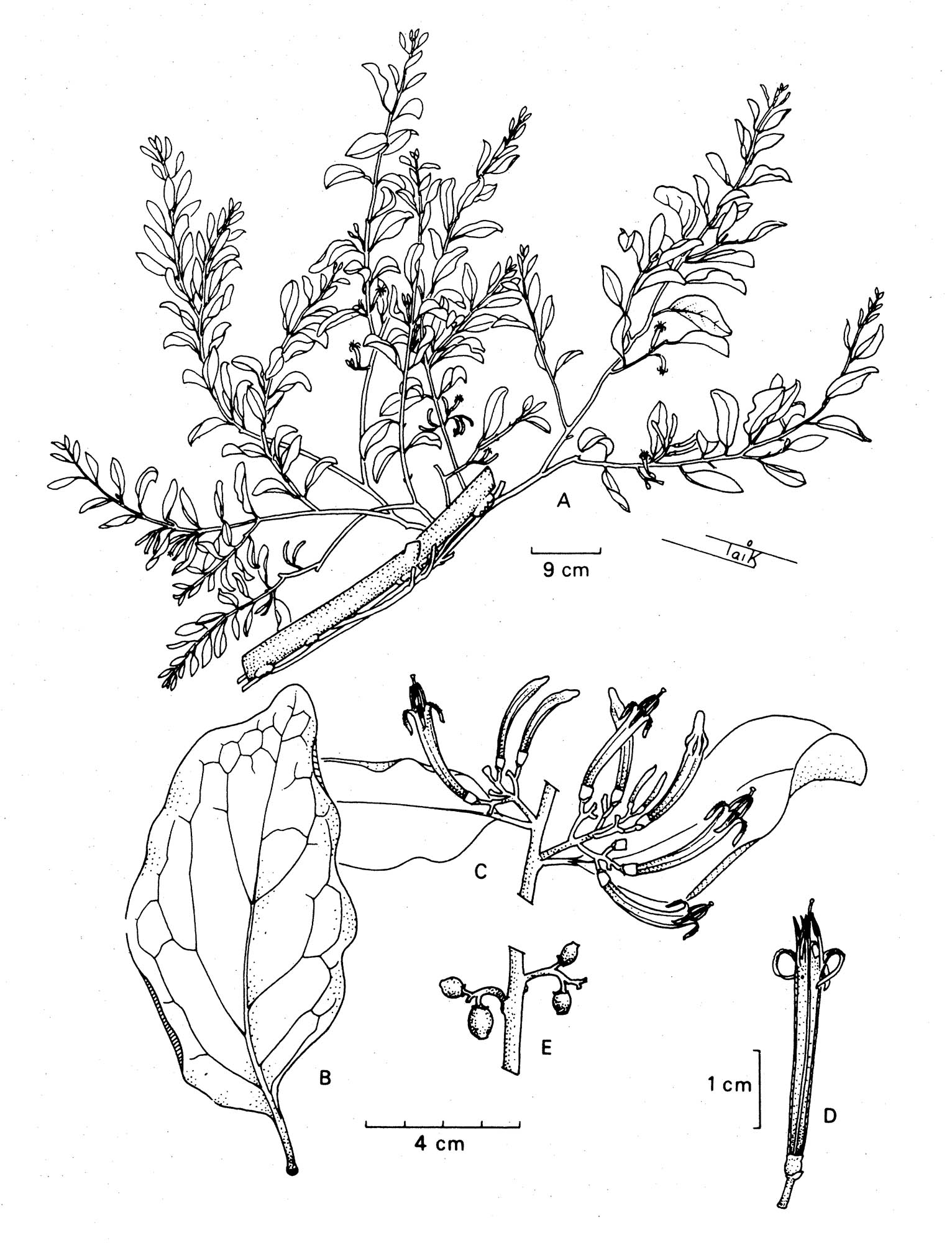
Dendrophthoe curvata (as D. falcata). A. living plant. B - leaf. C - inflorescences. D - longitudinal section of flower. E - infructescences. From Barlow (1981).
Photographs
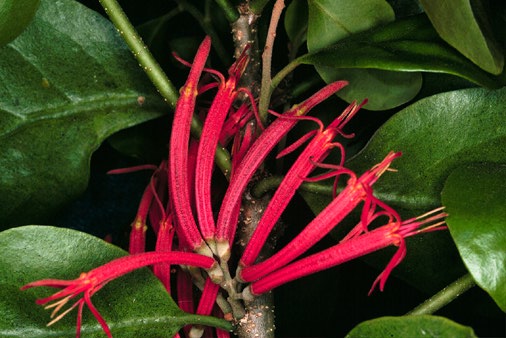
Dendrophthoe curvata. Red flowered form. Queensland, Australia. Parasitic on Punica granatum. [DLN 2787]. Photo by D. L. Nickrent.
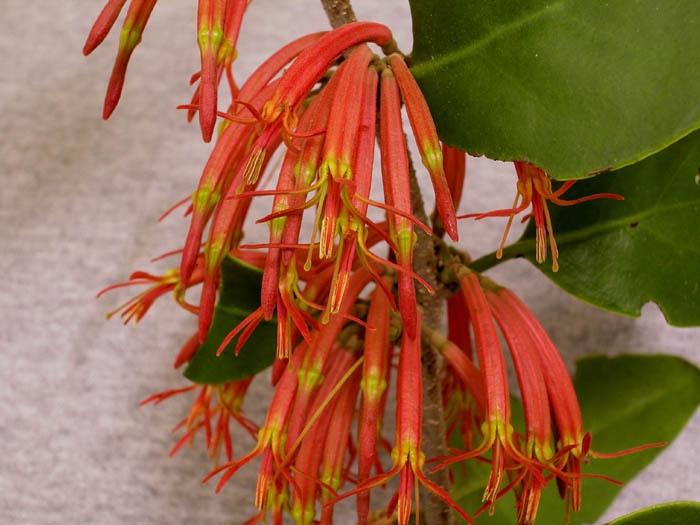
Dendrophthoe curvata. Orange flowered form. Queensland, Australia. Near Yungaburra, just SW of junction between A-Y 13 and road to Curtain Fig tree. Photo by D. L. Nickrent.
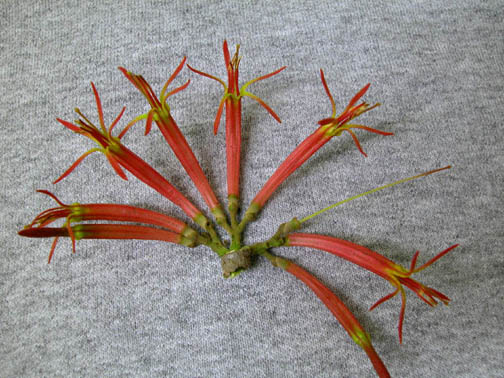
Dendrophthoe curvata. Orange flowered form, as above.
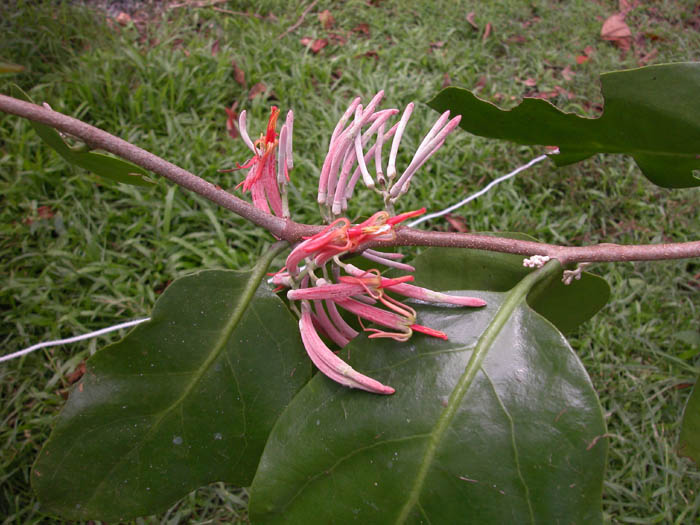
Dendrophthoe curvata. Note these flowers have a distinctive white bloom. Along Markham Point Road E of Oomsis, Morobe District, Papua New Guinea. 347 ft (105 m) elev. [DLN 4460] Photo. by D. L. Nickrent.
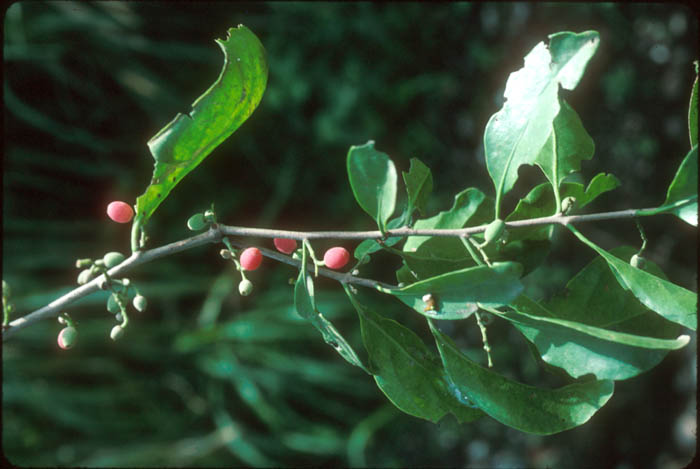
Dendrophthoe curvata, in fruit. [DLN 4478]. Photo. by D. L. Nickrent.
Dendrophthoe curvata
updated 20 January 2007